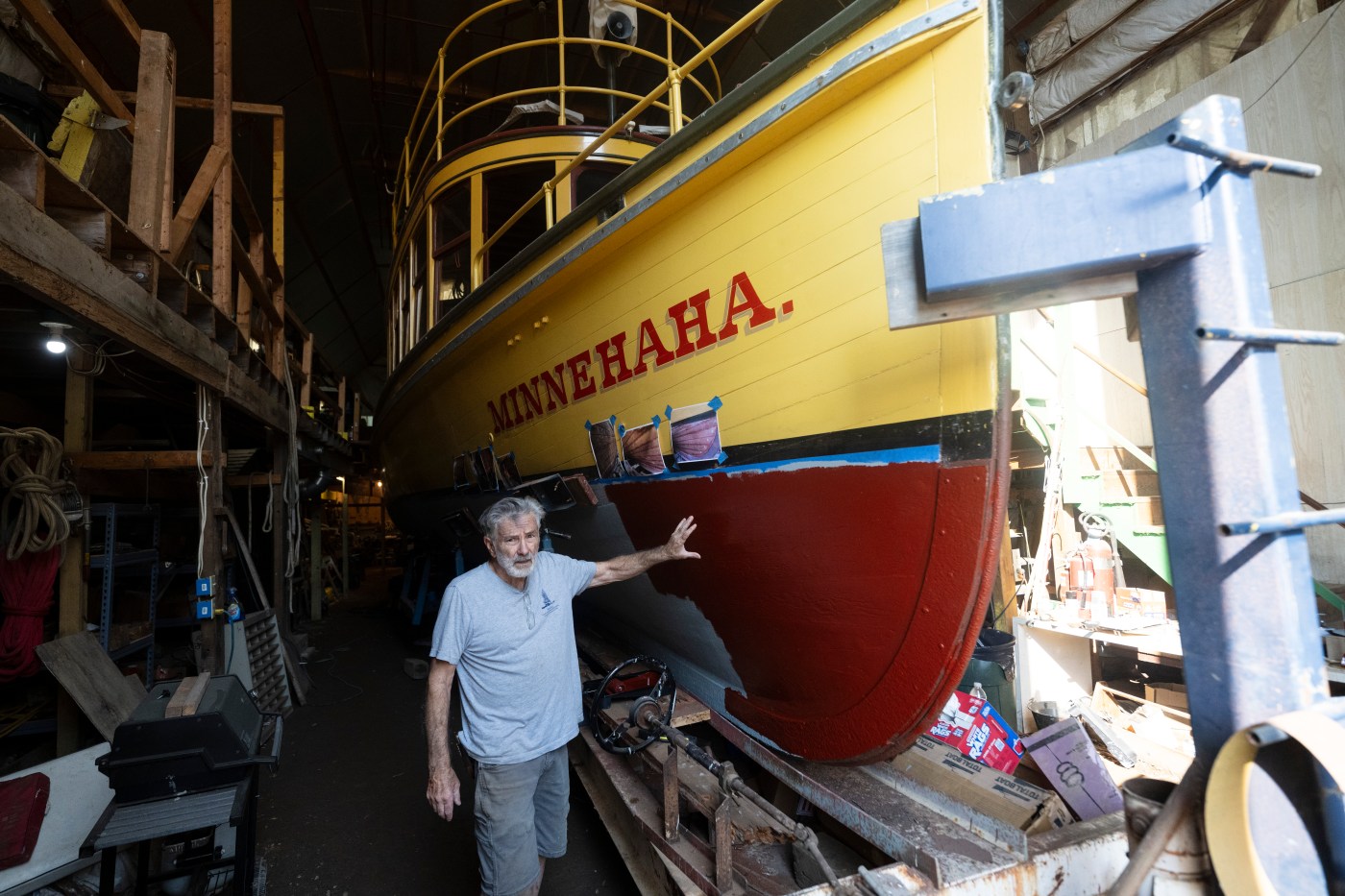
Lake St. Croix Beach wooden boat restoration company is wrapping up its biggest project to date
Sometimes a career can be launched by a simple twist of fate — or by an old guy named Jeep.
After graduating from St. Bernard’s High School in St. Paul in 1965, Tom Sweeney joined the U.S. Coast Guard. His first assignment was at the Coast Guard’s Life Saving Station in Milwaukee.
“I was the brand-new guy right out of boot camp, so they said, ‘Sweeney, you got to go work on that old boat with the old guy,’” he said.
The Coast Guard was still using wooden boats at some of its stations, he said, and the Milwaukee Life Saving Station had an all-wood double-ended 1939 rescue boat in its fleet.
“It was the only wood one we had, and so I had to spend the first winter with the old guy named Jeep, who was a retired fisherman, who they hired to put a new bottom on this boat,” Sweeney said. “I spent the winter lying under that boat with him, and him showing me every detail. He would say things to me like, ‘Now, Sweeney, remember, next summer you’re going to be out in a storm on this boat, and if we do this wrong, you could die. I won’t, because I’ll be at home.’”
From then on, Sweeney “was the wood-boat guy,” he said.
“I had friends at the yacht club near the Coast Guard station that would have me work on theirs because everybody in those days had wood boats,” he said. “I started doing that in my spare time, and I’ve been doing it ever since.”
Sweeney, the owner of BoatArt Classic Boat Restorations in Lake St. Croix Beach, has since rebuilt or repaired nearly every kind of wooden boat you could imagine.
He once repaired and restored an 1895 Harbor Launch boat owned by a family in Orono. He once stripped and stained a 36-foot power boat from Turkey and put 26 coats of varnish on it. He built a new windshield for a 25-foot 1954 Chris Craft mahogany cruiser. He’s currently overseeing the restoration of a 1937 runabout built by Ontario-based Peterborough Canoe Co.
“They built five of these, but there’s only one left in the world, and that’s this one,” he said, pointing to the 20-foot Peterborough during a recent tour. “They were built like a giant canoe. It was built strictly with canoe ribs.”
Next to the Peterborough in BoatArt’s workshop on Quasar Avenue is a 1957 Volvo Penta Aquamatic sterndrive, the first boat to combine an inboard engine with an external propeller unit.
“It’s our pièce de résistance,” Sweeney said. “It’s the only one of its kind in the world, and we got it. It was a wreck, and we rebuilt the whole thing.”
Minnehaha steamboat
A black-and-white photo of the passenger steamship Minnehaha on Lake Minnetonka in 1909. (Courtesy of Lake Minnetonka Historical Society)
Sweeney and his crew have spent much of the summer working in Excelsior on their biggest project to date: the rehabilitation of the wooden hull of the 1906 Minnehaha passenger steamboat.
The Minnehaha was one of six passenger steamboats built and operated by the Twin Cities Rapid Transit Co., the precursor to Metro Transit. Streetcars from Minneapolis would bring passengers to the Excelsior and Deephaven stations, where they would board steamboats, from May through September, for passage to the other side of the lake.
“The service accommodated the more than 20 docks around Lake Minnetonka,” according to “The Streetcar Boat Named Minnehaha,” an article published in the Spring 2024 issue of Hennepin History magazine. “The Express Boat service was advertised in Twin Cities newspapers as the ‘best’ and riders (and readers) agreed. On weekends, visitors flocked to Lake Minnetonka for rides; on weekdays, the streetcar boats were filled with commuters. Estimates reveal that by 1918, the Express Boats were serving about 200,000 passengers, but that’s when ridership began to decrease.”
“The streetcar company built them because, at that time, the streetcars stopped in Excelsior and Deephaven,” Sweeney said. “The road system had not been developed around the lake, and people needed to get to the far end. Traveling by steamboat was the quickest and easiest way to get to the far end of the lake.”
After 20 years of service, however, the road system improved, and the Minnehaha and two other steamboats were stripped of valuable parts and scuttled — sunk on purpose — in 1926 in deep water north of Big Island in Lake Minnetonka. “They just weren’t in use as much,” Sweeney said. “There was less need for them. The others are still down there.”
In 1980, the Minnehaha was raised and later restored by volunteers and returned to service in 1996. It provided rides to passengers until 2019, when it lost access to its launch site.
Now, the Minnehaha, which is owned and maintained by the Lake Minnetonka Historical Society, is in a storage facility in Excelsior while society officials work to find a permanent launch site.
Enter BoatArt
BoatArt owner Tom Sweeney describes some of the hull repairs he and his crew have performed on the wooden steamboat Minnehaha at the Lake Minnetonka Historical Society’s boat shed in Excelsior. (John Autey / Pioneer Press)
Society officials hired BoatArt to rehabilitate the Minnehaha’s hull, and Sweeney and his crew have spent the summer commuting between Lake St. Croix Beach and Excelsior to work on the boat, which was listed on the National Register of Historic Places in 2021. Among their tasks: replacing wood frames and planks; caulking the hull; repainting the bottom of the boat; and replacing six of the vessel’s steam-bent ribs.
Restoring such a massive piece of history is difficult because “everything is heavy and big,” Sweeney said.
“It’s very hard work,” he said. “The planks are two inches thick and 18 feet long, so they weigh a ton, you know, and everything is from the bottom, so you’re underneath the boat, working overhead.”
On a recent Tuesday afternoon, BoatArt employees Hannah LaPlant and Lily Vraa worked on the Minnehaha’s stern. LaPlant, who has been traveling from her home in Cornucopia, Wis., to work on the Minnehaha, used oakum (hemp fibers that have been soaked in pine tar) to caulk the steamship’s seams.
Related Articles
Author Kao Kalia Yang to debut new book at St. Paul’s Battle Creek Middle School
Trucker’s memorable payload: a giant loon, hauled from L.A. to St. Paul
Metro Transit seeks to expand service by 35% through 2027. Here’s the new routes.
Rob Lowe to emcee gala Friday as Hazelden Betty Ford marks 75 years
DHL sues MyPillow, alleging company founded by Mike Lindell owes $800,000
It takes “miles and miles” of oakum to caulk a boat the size of the Minnehaha, she said.
“We put cotton in first, and then we put the oakum in,” she said, stuffing a piece of cotton into an ⅛-inch-thick space above her head. “The oakum is thicker. All these seams have a bevel, so that they’re tighter at the top of the thickness, and then they’re wider at the bottom.”
Once both materials were wedged into the space, Vraa planned to seal it with a seal compound — a sand-and-linseed-oil mixture — and then sand that down and put primer on it.
“It’s a unique project, and we have fun working together,” LaPlant said. “Even though it gets dirty and gross at some point, we like hanging out with each other, so that’s fun.”
The Minnehaha is the biggest boat that Vraa, of St. Paul, has ever worked on. “It’s been a really exciting opportunity, honestly,” she said.
‘A lot of problem solving’
Charley Klima of BoatArt works on a plank on the wooden steamboat Minnehaha at the Lake Minnetonka Historical Society’s boat shed in Excelsior. The BoatArt crew has spent the summer commuting between Lake St. Croix Beach and Excelsior to work on the boat, which was listed on the National Register of Historic Places in 2021. (John Autey / Pioneer Press)
Volunteers from the Lake Minnetonka Historical Society have worked to make sure the Minnehaha looks as it did when it was launched into Lake Minnetonka on May 2, 1906, Sweeney said.
“The steam engine that I’m looking at here is the exact model that was originally in this,” Sweeney said. “They found an exact replica in northern California. Isn’t that amazing? They had a new boiler made because boilers are tricky. You don’t want them failing. The seat frames are the actual seats from streetcars, but they replaced all the vinyl. This is exactly how all the seats were laid out. You can stand right here when this thing’s running wide open, and it’s going to go chug, chug, chug, chug.”
Restoring the Minnehaha takes patience and a “high tolerance for pretty gross, gnarly, repetitive work,” said LaPlant, a graduate of the Northwest School of Wooden Boatbuilding in Port Hadlock, Wash.
“There’s a lot of problem solving,” she said. “Every boat has its own issues; every boat has to be repaired differently. You’ve got to use your brain. It’s not just like you’re always just doing the same thing. You’re either doing something where it’s like, ‘This is very tricky. It’s kind of hurting my brain,’ or it’s just mind-numbingly boring and repetitive, with these breaks in between. It’s always one extreme or the other.”
Sweeney said he fell in love with wooden boats for their “gracefulness and beauty.” He loves how they flex, groan and creak and how they move through the water differently from today’s fiberglass, aluminum and steel boats.
“They don’t look like a giant tennis shoe,” he said. “They ride differently. They’re living objects. They’re organic. There’s just no pleasure to me in cutting into a fiberglass boat. It doesn’t do anything for me. … Wooden boats are just classy. They’re not splashy. They are simple elegance.”
Weekday job is weekend hobby
Sweeney specializes in restoring wooden Chris Craft boats, which were made in Algonac, Mich., and Lyman boats, which were made in Sandusky, Ohio. His crew is working on putting a new bottom on a 25-foot Chris Craft that dates back to 1946 and is owned by a “couple of fellas from North Dakota,” he said. “We’re getting a 35-foot Lyman in tomorrow from Port Clinton, Ohio. He’s having it delivered. It’s too big for us to haul.”
Sweeney, who grew up in St. Paul’s Midway neighborhood, said he joined the Coast Guard after high school because an uncle and older brother had served. He spent four years in the Coast Guard, serving as an engineman, and was stationed on Plum Island on Lake Michigan in Door County, Wis.
After his discharge, he lived on Washington Island, Wis., and worked on commercial fishing boats. He later went to college and got a bachelor’s degree in engineering from Marquette University in Milwaukee, and a master’s degree in engineering from Cardinal Stritch University in Milwaukee. He then moved to Superior, Wis., where he worked as a master shipfitter. He later taught at the University of Minnesota, specializing in statistical process control aspects of geometric tolerancing, and started his own company, a mechanical design firm called Modec.
Sweeney, who has been restoring boats since 1967, launched BoatArt Classic Boat Restorations about 15 years ago when he retired from the U of M and sold Modec. He moved the business to Lake St. Croix Beach, just north of Afton, about 10 years ago. He and his wife, Bonnie, split their time between an apartment in Minneapolis and their house next door to BoatArt.
BoatArt owner Tom Sweeney describes some of the hull repairs, including new ribs, his company has performed on the wooden steamboat Minnehaha. Sweeney said he fell in love with wooden boats for their “gracefulness and beauty.” (John Autey / Pioneer Press)
Sweeney, 77, said he’s lucky to have a job he would do for free. “On the weekends, this is my hobby,” he said. “On weekdays, this is my job. But it’s all the same thing.”
In addition to LaPlant and Vraa, other BoatArt employees have been integral to the success of the Minnehaha project this summer, Sweeney said, including Brian Dickie of Afton, Charley Klima of Afton and shop foreman Will Golden of Lake St. Croix Beach.
Sweeney leases the BoatArt warehouse space from Golden. “He does all the books, so I have to call him every month and say, ‘Hey, make sure you pay the rent. I don’t want that fool mad at us.’”
Funded by state grant
The Lake Minnetonka Historical Society received a nearly $105,000 grant through an appropriation to the Minnesota Historical Society from the Minnesota Arts and Cultural Heritage Fund to fund their work.
“Like an old house, things need repair from time to time, and boats are no different,” said Tom McCarthy, the society’s treasurer and manager of the Minnehaha project. “A wooden boat, because you’re putting it in water, is naturally susceptible to rot and other things, so it is very common to have to do preventative maintenance and occasional restoration or rehabilitation.”
Sweeney said six planks and about a half-dozen ribs, which support the planks, had to be replaced. “The biggest thing was in the stern, where there were rotten planks; some of that rot had also extended to the knees and frames, so those had to be replaced as well,” he said.
The BoatArt crew hopes to finish their work in the next few weeks.
BoatArt’s Lily Vraa looks in at the interior of the wooden steamboat Minnehaha at the Lake Minnetonka Historical Society’s boat shed in Excelsior. Built in 1906, the boat was scuttled in 1926 and raised again in 1980. (John Autey / Pioneer Press)
In the meantime, Lake Minnetonka Historical Society officials are searching for a permanent launch site for the Minnehaha. It was previously launched at a private ramp in Excelsior that was never intended to be a long-term solution, McCarthy said.
They’re looking for a launch site on Lake Minnetonka that can accommodate the Minnehaha’s size and draft (the distance from the water line to the bottom of keel), McCarthy said.
“We need a boat launch ramp that is 150 to 200 feet long,” he said. “The challenge is that no other boat needs a boat-launch ramp of those dimensions, and 99 percent of the lakeshore around Lake Minnetonka is fully developed. There just isn’t free land available.”
Related Articles
‘Stay there forever if we could’: After 106 years, MSP Plumbing, Heating and Air to leave Grand Avenue
10,000 Lakes Concours d’Elegance returns after 5 years — and a Stillwater couple has just the car for it
‘Field of Bands’ fundraiser to aid veterans and troops
Cottage Grove man had nearly 85 kilograms of meth in his garage, police say
Stillwater motorcyclist killed in crash at Highways 95 and 36
Another factor: The Minnehaha cannot be left in the water year-round. “She has a wooden hull, and she has a boiler, so she needs to be stored in a heated building that is adjacent to the ramp,” McCarthy said. “We have to do maintenance in the off season, and she can’t be allowed to freeze.”
McCarthy said he is optimistic that a suitable launch site will be identified soon.
“We are in the unusual dilemma of having this wonderful artifact that was brought up from the bottom of the lake, restored over a period of six years, all by volunteers, and now after serving for 24 years on the lake, is being fully rehabilitated, so she’s ready to go, but we don’t have a place to get her back in the water,” he said. “It’s one of the big ironies — we’ve got this wonderful treasure, but we can’t get her back to the public.”


